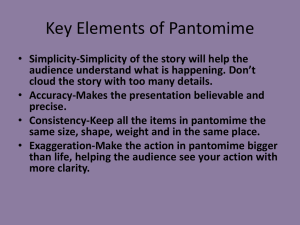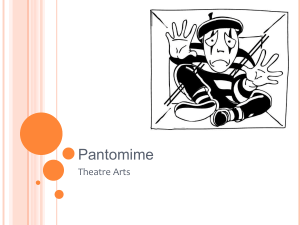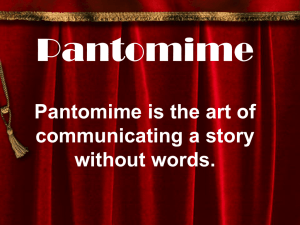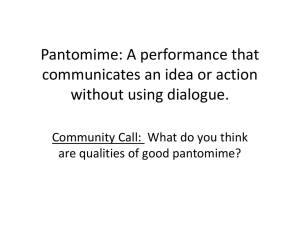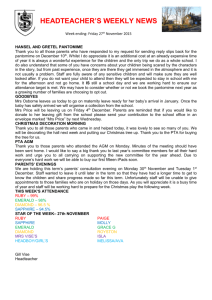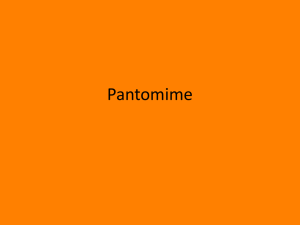Using Representations: Coordination of Symbols in Theory of Mind
advertisement
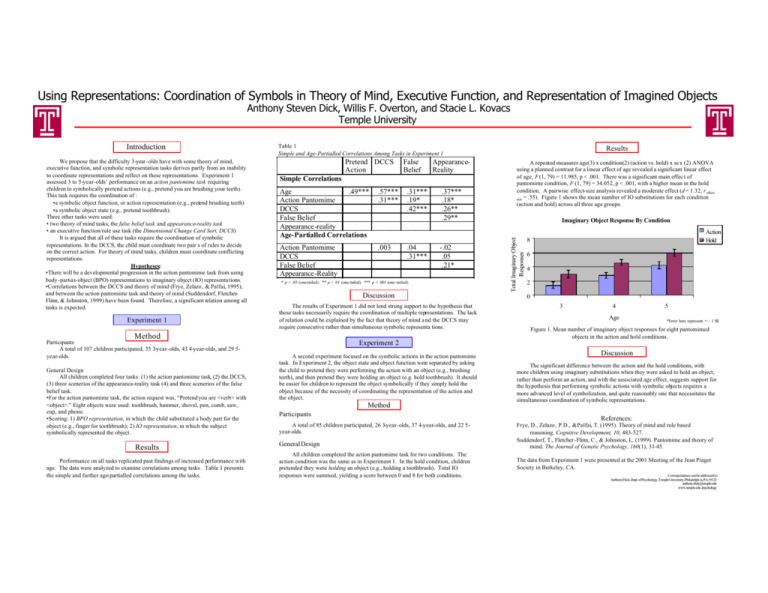
Using Representations: Coordination of Symbols in Theory of Mind, Executive Function, and Representation of Imagined Objects Anthony Steven Dick, Willis F. Overton, and Stacie L. Kovacs Temple University We propose that the difficulty 3-year -olds have with some theory of mind, executive function, and symbolic representation tasks derives partly from an inability to coordinate representations and reflect on these representations. Experiment 1 assessed 3 to 5-year-olds’ performance on an action pantomime task requiring children to symbolically pretend actions (e.g., pretend you are brushing your teeth). This task requires the coordination of : •a symbolic object function, or action representation (e.g., pretend brushing teeth) •a symbolic object state (e.g., pretend toothbrush). Three other tasks were used: • two theory of mind tasks, the false belief task and appearance-reality task • an executive function/rule use task (the Dimensional Change Card Sort, DCCS) It is argued that all of these tasks require the coordination of symbolic representations. In the DCCS, the child must coordinate two pair s of rules to decide on the correct action. For theory of mind tasks, children must coordinate conflicting representations. Hypotheses: •There will be a developmental progression in the action pantomime task from using body -part-as-object (BPO) representations to imaginary object (IO) representa tions. •Correlations between the DCCS and theory of mind (Frye, Zelazo , & Palfai, 1995), and between the action pantomime task and theory of mind (Suddendorf, FletcherFlinn, & Johnston, 1999) have been found. Therefore, a significant relation among all tasks is expected. Experiment 1 Table 1 Simple and Age-Partialled Correlations Among Tasks in Experiment 1 Pretend DCCS Action General Design All children completed four tasks: (1) the action pantomime task, (2) the DCCS, (3) three scenerios of the appearance-reality task (4) and three scenerios of the false belief task. •For the action pantomime task, the action request was, “Pretend you are <verb> with <object>.” Eight objects were used: toothbrush, hammer, shovel, pen, comb, saw, cup, and phone. •Scoring: 1) BPO representation, in which the child substituted a body part for the object (e.g., finger for toothbrush); 2) IO representation, in which the subject symbolically represented the object. Results Performance on all tasks replicated past findings of increased performance with age. The data were analyzed to examine correlations among tasks . Table 1 presents the simple and further age-partialled correlations among the tasks. AppearanceReality Simple Correlations Age .49*** Action Pantomime DCCS False Belief Appearance-reality Age-Partialled Correlations .57*** .31*** Action Pantomime DCCS False Belief Appearance-Reality .003 .31*** .19* .42*** .04 .31*** .37*** .18* .26** .29** -.02 .05 .21* * p < .05 (one-tailed). ** p < .01 (one-tailed). *** p < .001 (one -tailed). Discussion The results of Experiment 1 did not lend strong support to the hypothesis that these tasks necessarily require the coordination of multiple representations. The lack of relation could be explained by the fact that theory of mind a nd the DCCS may require consecutive rather than simultaneous symbolic representa tions. Method Participants A total of 107 children participated, 35 3-year-olds, 43 4-year-olds, and 29 5year-olds. False Belief Results A repeated measures age(3) x condition(2) (action vs. hold) x se x (2) ANOVA using a planned contrast for a linear effect of age revealed a significant linear effect of age, F (1, 79) = 11.985, p < .001. There was a significant main effec t of pantomime condition, F (1, 79) = 34.052, p < .001, with a higher mean in the hold condition. A pairwise effect-size analysis revealed a moderate effect (d = 1.32, r effect size = .55). Figure 1 shows the mean number of IO substitutions for each condition (action and hold) across all three age groups. Imaginary Object Response By Condition Total Imaginary Object Responses Introduction Action Hold 8 6 4 2 0 3 4 Age 5 *Error bars represent +/ - 1 SE Figure 1. Mean number of imaginary object responses for eight pantomimed objects in the action and hold conditions. Experiment 2 A second experiment focused on the symbolic actions in the action pantomime task. In Experiment 2, the object state and object function were separated by asking the child to pretend they were performing the action with an object (e.g., brushing teeth), and then pretend they were holding an object (e.g. hold toothbrush). It should be easier for children to represent the object symbolically if they simply hold the object because of the necessity of coordinating the representation of the action and the object. Method Participants A total of 85 children participated, 26 3-year-olds, 37 4-year-olds, and 22 5year-olds. General Design All children completed the action pantomime task for two conditions. The action condition was the same as in Experiment 1. In the hold condition, children pretended they were holding an object (e.g., holding a toothbrush). Total IO responses were summed, yielding a score between 0 and 8 for both conditions. Discussion The significant difference between the action and the hold conditions, with more children using imaginary substitutions when they were asked to hold an object, rather than perform an action, and with the associated age effect, suggests support for the hypothesis that performing symbolic actions with symbolic objects requires a more advanced level of symbolization, and quite reasonably one that necessitates the simultaneous coordination of symbolic representations. References: Frye, D., Zelazo , P.D., & Palfai, T. (1995). Theory of mind and rule based reasoning. Cognitive Development, 10, 483-527. Suddendorf, T., Fletcher -Flinn, C., & Johnston, L. (1999). Pantomime and theory of mind. The Journal of Genetic Psychology, 160(1), 31-45. The data from Experiment 1 were presented at the 2001 Meeting of the Jean Piaget Society in Berkeley, CA. Correspondence can be addressed to: Anthony Dick, Dept. of Psychology, Temple University, Philadelph ia, PA 19122 anthony.dick@temple.edu www.temple.edu /psychology
